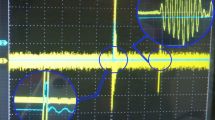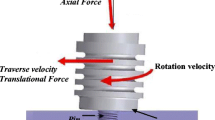Abstract
This paper presents an optimized design method for an ultrasonic flow meter (USFM) used in the semiconductor manufacturing field for liquid flow measurement. Based on fluid simulation, the impact of different inlet tube section angles on the velocity distribution within the measuring tube section of the USFM was analyzed, and a suitable inlet tube section angle of 45° was determined. Based on the average flow velocity on the acoustic channel line and the average flow velocity in the measuring tube section, a velocity correction factor was calculated to adjust the measured flow velocity to the actual flow velocity of the tested fluid. The USFM prototype was calibrated for flow rate and a compensation factor obtained to correct measured flow rate. The accuracy of the USFM was tested and found to reach 1.5 level, meeting the needs for liquid flow measurement in the semiconductor manufacturing field.
Similar content being viewed by others
Abbreviations
- v :
-
Flow velocity
- ρ :
-
Density
- p :
-
Pressure
- v n :
-
Vibration velocity
- t u :
-
Downstream flow propagation time
- t d :
-
Upstream flow propagation time
- Δt :
-
Time difference
- Q :
-
Instantaneous flow
- K :
-
Flow velocity correction factor
- u l :
-
Line average flow velocity
- u s :
-
Area average flow velocity
References
L. C. Lynnworth, Ultrasonic Measurements for Process Control: Theory and Techniques, Applications, Academic Press, London (2013).
Y. Inoue, H. Kikura and H. Murakawa, A study of ultrasonic propagation for ultrasonic flow velocity measurement, Flow Measurement and Instrumentation, 19 (2008) 223–232.
Y. Zhao, Q. Wei, M. Li and Y. Lei, Design and implementation of an external clamped ultrasonic flowmeter based on time difference method, IEEE International Conference on Computer Science, Electronic Information Engineering and Intelligent Control Technology (CEI), Fuzhou, China (2021).
K. Zhu, X. Chen, M. Qu, D. Yang, L. Hu and J. Xie, Non-contact ultrasonic flow measurement for small pipes based on AlN piezoelectric micromachined ultrasonic transducer arrays, Journal of Microelectromechanical Systems, 30 (2021) 480–487.
L. Lynnworth and Y. Liu, Ultrasonic flowmeters: half-century progress report, Ultrasonics, 44 (2006) e1371–e1378.
J. M. Zhao, A. Larios and F. Bobaru, Construction of a peridynamic model for viscous flow, Journal of Computational Physics, 20 (2022) 468.
F. S. Zhang, Z. D. Zhou and H. Zhang, A new single formula for the law of the wall and its application to wall-modeled large-eddy simulation, European Journal of Mechanics B-Fluids, 94 (2022) 350–365.
A. U. Rehman and Z. Abbas, Stability analysis of heat transfer in nanomaterial flow of boundary layer towards a shrinking surface: hybrid nanofluid versus nanofluid, Alexandria Engineering Journal, 61 (12) (2022) 10757–10768.
E. Mandard, D. Kouame, R. Battault, J.-P. Remenieras and F. Patat, Methodology for developing a high-precision ultrasound flow meter and fluid velocity profile reconstruction, IEEE Trans. Ultrason. Ferroelectr. Freq. Control, 55 (1) (2008) 161–172.
M. Simño, M. Besharat, A. Carravetta and H. M. Ramos, Flow velocity distribution towards flowmeter accuracy: CFD, UDV, and field tests, Water, 10 (12) (2018) 1807.
D. van Willigen, P. van Neer, J. Massaad, N. Jong, M. Verweij and M. Pertijs, An algorithm to minimize the zero-flow error in transit-time ultrasonic flow meters, IEEE Transactions on Instrumentation and Measurement, 70 (2020) 1–9.
S. Peng, W. Liao and H. Tan, Performance optimization of ultrasonic flow meter based on computational fluid dynamics, Advances in Mechanical Engineering, 10 (8) (2018).
M. J. Rincón, M. Reclari and M. Abkar, Turbulent flow in small-diameter ultrasonic flow meters: a numerical and experimental study, Flow Measurement and Instrumentation, 87 (2022) 102227.
P. Li, K. Zhang and Q. Xu, Experimental study on the correction factor of surface overland flow velocity, Catena, 20 (2022) 218.
Z. Belligoli, R. Dwight, G. Kok and P. Lucas, A bayesian study of uncertainty in ultrasonic flow meters under non-ideal flow conditions, Metrologia, 54 (4) (2017) 584.
Z. Wang, Q. Chen, D. Li and S. Liu, Bias error in measurement of complex flow regime with ultrasonic flowmeter, Journal of Physics: Conference Series, 2264 (2022) 012031.
D. Scholl, F. Ebert and P. Leistner, The influence of mean flow velocity and direction on the acoustic transmission behavior of right-angled duct bends, Applied Acoustics, 20 (2021) 184.
L. Ma, J. Liu and J. Wang, Study of the accuracy of ultrasonic flowmeters for liquid, AASRI Procedia, 3 (2012) 14–20.
Acknowledgments
This work is supported by the Natural Science Foundation of Zhejiang Province, China (No. U21A20134).
Author information
Authors and Affiliations
Corresponding author
Additional information
Chang Chen completed his Ph.D. degree at Huazhong University of Science and Technology in 2013. He is currently a Professor in the School of Mechanical Engineering at Hangzhou Dianzi University. His research subjects are engaged in multi-domain unified modeling theory and technology, the design and application of soft robots, and electromechanical integration technology.
Weijie Sun is a graduate student studying at Hangzhou Dianzi University. His research direction is the design of ultraclean fluidic components.
Rui Zhou is studying for a master’s degree in mechanical engineering at Hangzhou Dianzi University. His research direction is the structural design of ultraclean flow control components used in semiconductor production.
Chen Lin is a graduate student studying at Hangzhou Dianzi University. His research direction is machine vision and intelligent manufacturing.
Changyong Chu is an Associate Professor from Hangzhou Dianzi University. He obtained his Ph.D. from Nanyang Technological University. His area of research includes model base system engineering, digital thread, and intelligent manufacturing.
Shaohui Su completed his Ph.D. degree at Zhejiang University in 2007. He is currently a Professor in the School of Mechanical Engineering at Hangzhou Dianzi University. His research subjects are engaged in multi-domain unified modeling theory and technology, mass customization and digital twins technology.
Rights and permissions
About this article
Cite this article
Chen, C., Sun, W., Zhou, R. et al. Optimization design and research of ultrasonic flowmeter based on time difference method. J Mech Sci Technol 38, 245–258 (2024). https://doi.org/10.1007/s12206-023-1221-z
Received:
Revised:
Accepted:
Published:
Issue Date:
DOI: https://doi.org/10.1007/s12206-023-1221-z




